Knowing Filipino Food: Spice (and all things nice)
Answers to the questions: "is Filipino food spicy?" and "why is Filipino food so bland?"
At a recent wedding fair in south London where I was showcasing my services as a wedding caterer, as exemplified by a small selection of (what I’m certain were) delicious and eye-catching Filipino canapés, I had a rather interesting interaction that made me smile (ruefully) inside:
Him: “Oh, this is different, what’s this?”
Me: “It’s Filipino food. Would you like to look at and try some of the samples?”
Her: “Oh, I don’t eat anything spicy”
Me: “Well, you’re in luck, because Filipino is not really - “
Her: “Yeah, it’s alright, I’m allergic to spicy things, no thank you”
Me: “Okay, no problem, enjoy the rest of…”
*her giving me a sharp glance as she walks off quickly*
Hah! There’s a lot to unpack here - about customer service, customer manners, how to explain Filipino food in an easy soundbite, reactions to and assumptions about difference, strange food intolerances; but the one thing I want to focus on today, because it was most salient in my mind immediately after this conversation, was the automatic assumption that Filipino food is spicy.
This is perhaps one of the biggest misconceptions I face when explaining what Filipino food is, especially to white Brits (cue hackneyed jokes about how wypipo can’t handle spice and flavour). It’s one of the first questions I’m often asked: “is it spicy?” It’s not a terrible one to start off with, given the reputation of many other southeast Asian cuisines for elevated levels of spice (that one time I went on a Thai food crawl, I was burning up inside by the end of the evening), and the roughly shared climate and geography. It’s perhaps natural for an outsider to assume that spice is a shared characteristic across the region.
But it’s a funny one to me, because one of the big complaints I hear about Filipino food, especially from other southeast Asians (and other cultures that love chillies), is that Filipino food is so bland. Well, I say funny… it actually annoys me quite a fair bit, because quite often these opinions (especially online) are driven by a heady cocktail of ignorance, assumption-making, lack of clarity, uncharitable attitudes… and rage-baiting.
So: is it about time that we bring some clarity to this issue (or muddy the waters with a lengthy essay that just complicates things)?
Before I tackle it though, it’s worth checking in with you that we’re all clear about what we’re talking about. When I am talking about spice in this essay, I am primarily talking about the heat brought by chillies and peppers, because that is the most common understanding of the term. But, at times I will also cover off the wider meaning of spice - things like cinnamon, turmeric, cloves etc. - and their general usage because it is also pertinent to the discussion.
So, bearing that in mind, let’s look at the presence and role of spice in the various Filipino cuisines.
**********
We do actually use spice… or at least, some of us do
The first thing to cover off is that when we talk about spice in Filipino food, we should specify what Filipino foods we are talking about. As an archipelago forcibly united by colonisation, the Philippines encompasses a number of varying cuisines, each with their own preferred ingredients, flavours and cooking techniques.
Amongst those cuisines, some of them have a reputation for being spicy. Bicolano food, from the Bicol region of southeast Luzon, is perhaps the most well-known. There, the usage of siling labuyo/wild chillies is quite marked, and lends some real heat to popular dishes such as laing (taro leaves cooked down in coconut milk), kandingga (offal in coconut milk) and the Bicolano version of dinuguan (blood stew). Of course, what Filipinos might consider be to ‘real heat’ is perhaps subjective, and having never been to Bicol myself I cannot attest to how spicy it can really get. But it remains a fact that Bicolano cuisine is one that has a great love for chilli. Although apparently, I am now learning that the cuisine of Apayao may be hotter.
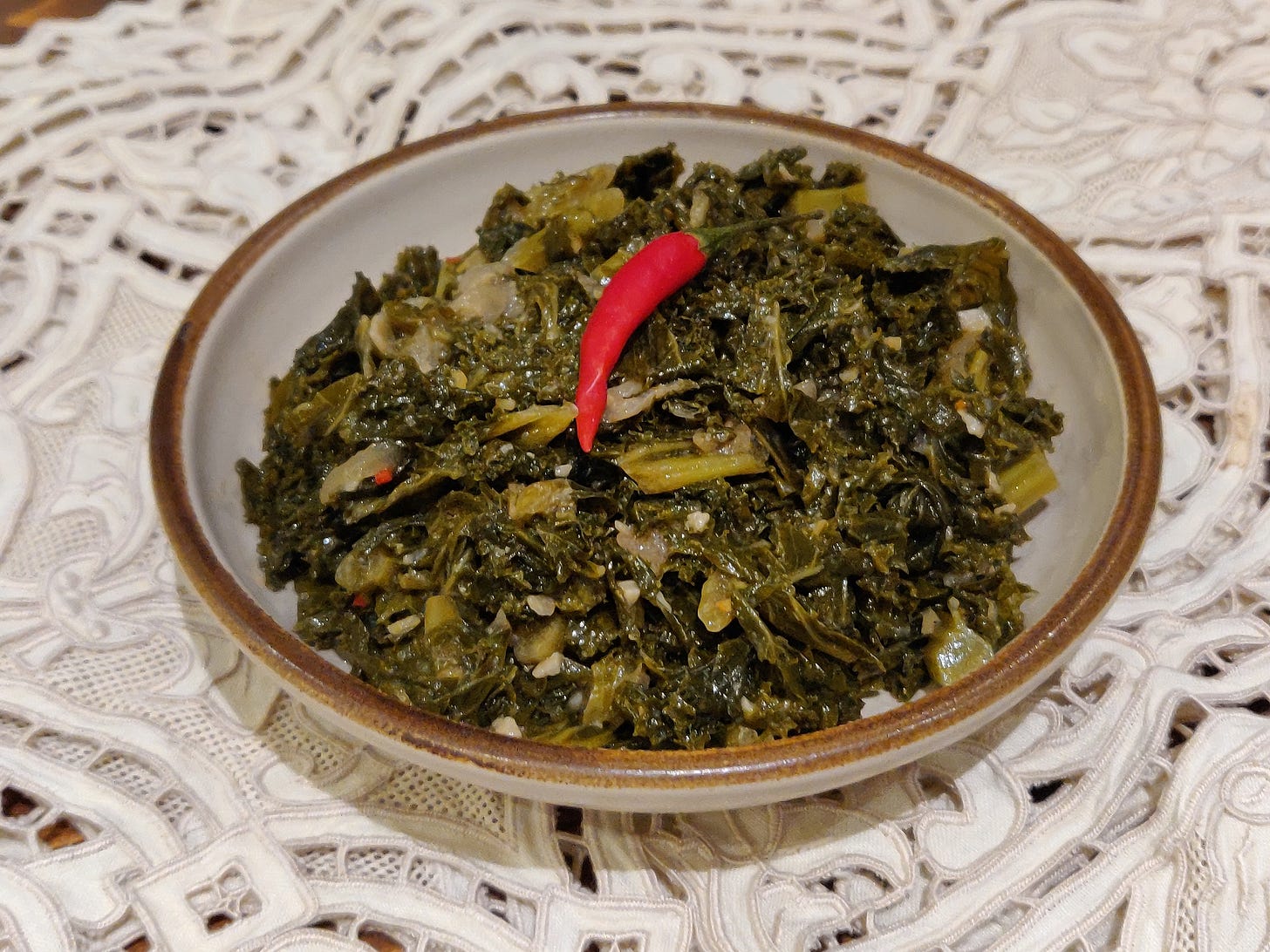
If we head down south, to Mindanao, you will find more chilli (and indeed spice pastes) in use, particularly amongst the Muslim Moro cuisines. My first introduction to Muslim Moro food was through piaparan, a Maranao dish, and palapa, what I call the sofrito of Mindanao. Both have, from a Filipino perspective, a startling number of chillies in them.

Unsurprisingly, newcomers to these cuisines often remark on the similarities to Indonesian and Malaysian cuisines. There is a shared history and heritage of course: the sultanates of Brunei, Sulu and Maguindanao overlapped very frequently over the years, and the peoples of this part of the world flowed to-and-fro across these key crossroad seas mostly without hindrance (all of which now means that with the hardening of national boundaries, there are opposing claims and land disputes between the Philippines and Malaysia). I will touch upon this a bit later on in the essay.
But yes, it is true that in general many Filipino cuisines are not that chilli-heavy. It just so happens that many of those cuisines - Kapampangan, Tagalog Manila, Cebuano and Visayan - are the ones most frequently encountered by non-Filipinos, who visit the cities and beaches of those cuisines’ respective homelands.
That’s not to say though that chillies are not used in these cuisines and others in the Philippines.
How we use spice is perhaps not the way you’d expect it
We might add a bit of chilli to a dish here and there - dinuguan always benefits from a bit of mild heat (brought on by the milder siling haba/long chilli), and in my opinion so does ginataan. I wonder if the Bicolano love of chillies is because it pairs so well with the coconut milk that they use so abundantly in their cookery, which does a wonderful job if tempering and ameliorating the heat. Ultimately, spice usage often comes down to personal or regional preference and is often not in huge quantities, so it can fly under the radar.
But for those who say that they didn’t encounter any spice (chillies) during their stay? I always think: did you not see the little sets of ingredients for making sawsawan?

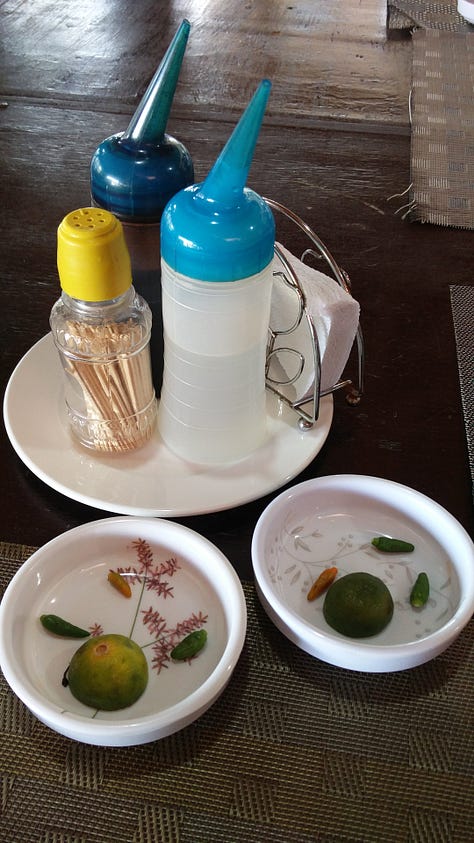
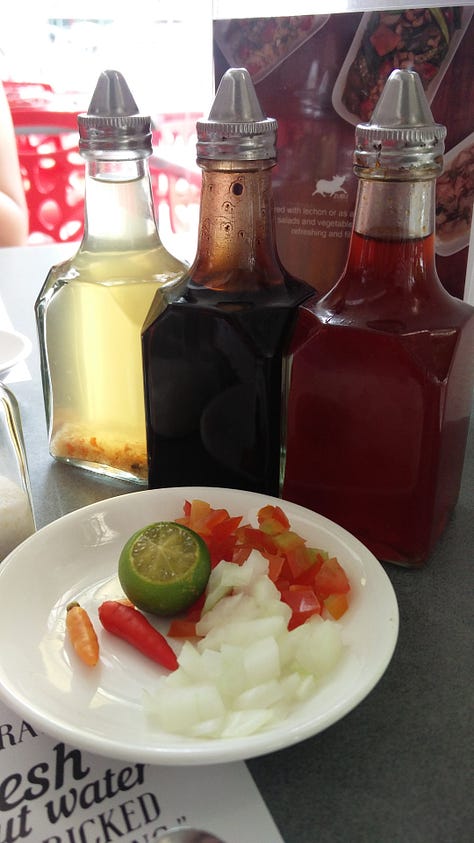
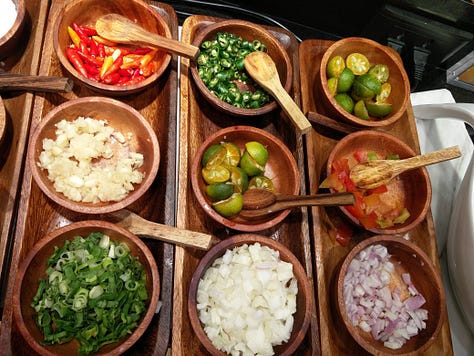
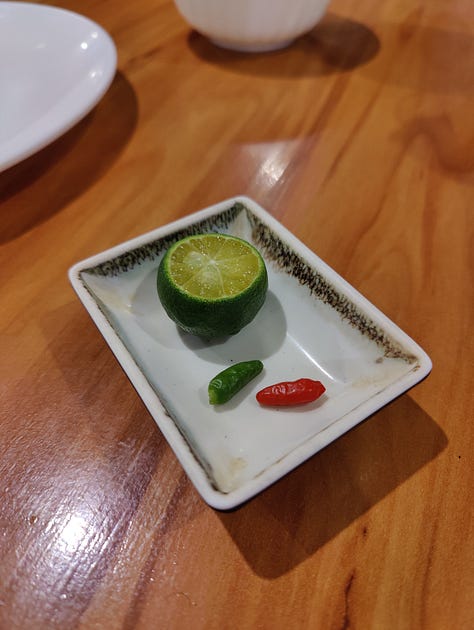
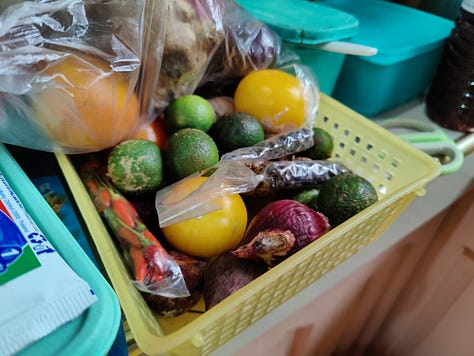
Sawsawan can be roughly translated as a dipping sauce, a condiment that you would use to flavour your dish. They are ubiquitous on Filipino tables. Some are specific to a dish - kare kare, for example, is almost always paired with bagoong alamang/fermented shrimp paste - but more commonly it’s a set of ingredients from which you can make your own sawsawan. In the pictures shared above, you can see: soy sauce, vinegar, patis/fish sauce, calamansi, siling labuyo, black pepper, chopped onions and shallots, chopped tomatoes, spring onions, chopped garlic… they provide for an endless number of combinations. One day, I might feel like crushing the chillies into my toyomansi (soy sauce and calamansi), infusing a troubling amount of heat into the sauce. Other days, I might just let the chilli sit, unbroken and imparting a milder kick, and add some chopped tomatoes instead.
Sawsawan therefore enters the realm of the personal: no person’s dipping sauce is the same as someone else’s. It therefore becomes more than just a condiment; it becomes the means by which you personalise and make the food your own. One commenter I saw on Reddit mused that when cooking in bulk for larger numbers of people with varying different taste preferences, it’s better to create a simply-flavoured baseline dish upon which the diners can further elaborate - which chimes with other readings that see the role of sawsawan as being one that allows the diner to be the finishing chef of their own meal. In her writings, Doreen G Fernandez enshrined the place of sawsawan in Filipino culinary heritage, detailing the role it has played in the development of our foods:
It is the indigenous cuisine that has stood steadfast and unchanged even in the onslaught of foreign tastes… its relishes and dipping sauces (sawsawan) are still used by many to tune the foreign taste to the local tongue…
Sawsawan adds flavour, it adds taste. It can even add heat. So how can Filipino food be considered bland? I suspect, based on anecdotal evidence, that this stems in part from an outsider’s fundamental misunderstanding of sawsawan. Many dishes require sawsawan, and many dishes would not be complete without the addition of something to it. Take the kare kare I cited earlier: the oxtail/beef peanut stew almost always comes with bagoong alamang. Consequently, it is often flavoured and cooked in expectation of the diner adding the salty, funky umami bagoong to their liking. Having the kare kare on its own might not be so flavourful, but with the infusion of bagoong it is transformed into a powerful taste experience.

When my brother and I first started serving kare kare at our supper clubs, we followed this doctrine. What we found though, was that often those who were unfamiliar with the bagoong would leave it untouched, because it smelled or tasted too strangely for them (here’s a thought: would you eat a spoonful of salt or soy sauce just by itself?). They weren’t adding it to their kare kare! So the dish wasn’t reaching its full potential. It’s why, to this day, I blend the bagoong into the kare kare in advance, so that people can’t make the same mistake (though conversely, many Filipinos enquire for extra bagoong, because they don’t expect that the kare kare has already been flavoured with it). It does feel like I am cheating a bit, but at the same time I think it’s a fair allowance for me to ensure that the food I cook is enjoyed at its best.
I am also reminded of a sight I saw in Cebu City once, during the raucous Sinulog festival that takes place every January in honour of the Santo Niño. My wife and I had popped in to a lechon (roast pork) joint for a late night merienda, when we saw a bit of an amusing but also sad sight. Sat by himself, staring blankly (and drunkenly?) out the window, was a foreigner all daubed in paint (throwing paint and dyes on people has become a popular Sinulog pastime), waiting for his food to arrive. When it did, it was just a plate of chopped up lechon. No rice, no veg, nothing else. The waitress gestured, almost pleadingly, at the assorted condiments at the side of the table (“try it with some vinegar, please sir…”), but he just waved her away and started stuffing plain lechon into his mouth. Now, roast pork is delicious in its own right, but Cebuano roast pork becomes elite with the addition of spiced vinegar. And yet, here was a foreigner, just raw-dogging a plate of pork. Was he really enjoying the food at its best? Or would he come away thinking that the supposedly famous Cebu lechon was a bit of a sham?
Even when the condiments are enjoyed, they may still not be fully understood. Closer to home, I remember reading Jonathan Nunn’s review of Asian Harvest, an Ilocano butcher and turo-turo restaurant, for Vittles (which I visited with him, and also wrote about myself) and being struck by how considered and insightful it was. But when it came to describing Asian Harvest’s “elite dozen-strong condiment section”, Jonathan wrote about pickled chillies, a condiment I certainly did not remember from my meal with him. It all became clearer when I saw the subsequent photo, showing someone scooping chillies out of the spiced vinegar. There was clearly a difference in perspective here, between the Filipino who would enjoy the vinegar and leave the chillies to continue floating in peace, and the non-Filipino who thought that they should be eating those very same chillies; it produces a very, very different spice experience. And yes, spiced vinegar is extremely popular in the Philippines, and I currently have three different types (one home-made) in my kitchen.
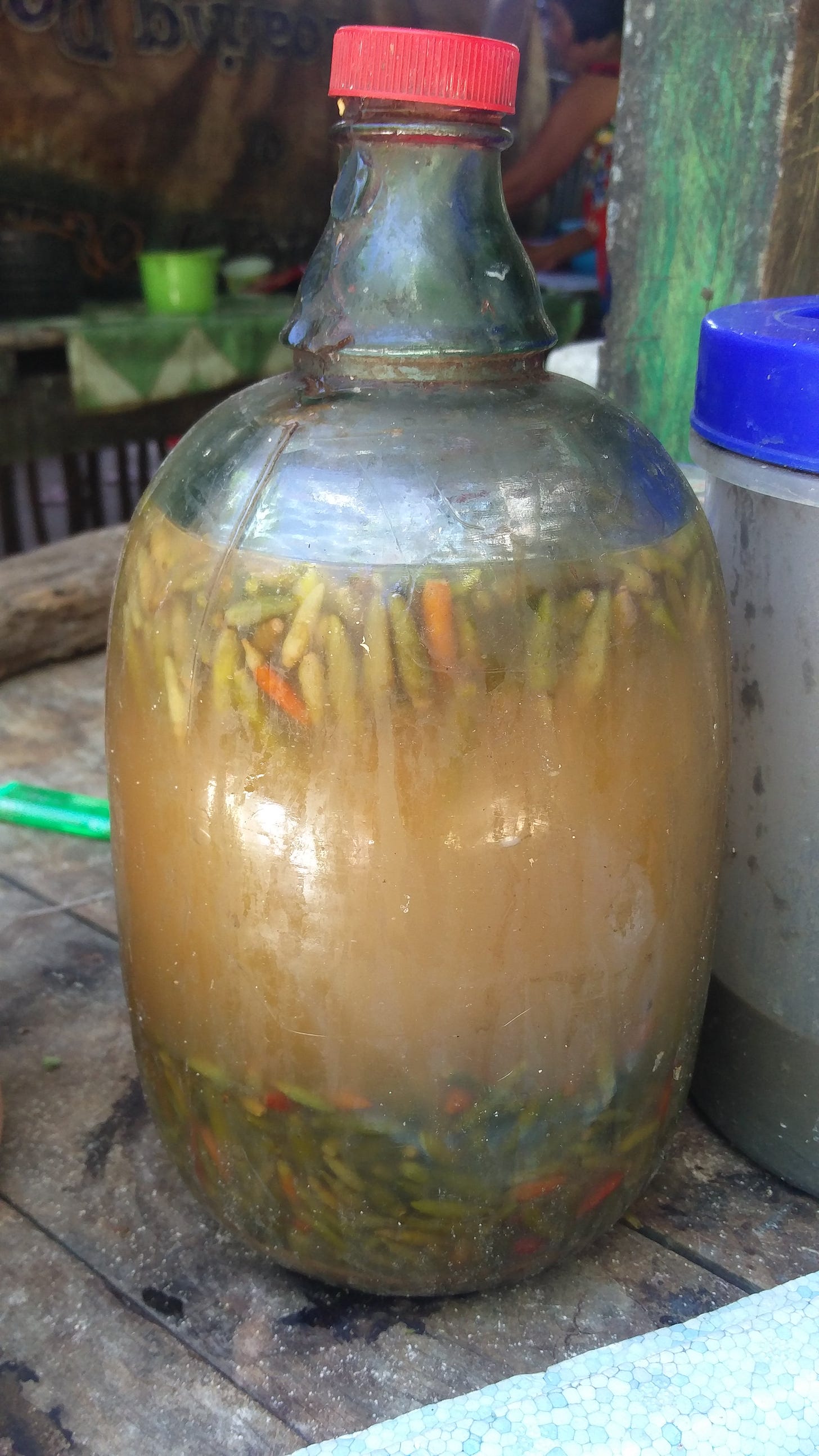
I do wonder then: is the Filipino approach to spice and flavouring, as exemplified by the concept and usage of sawsawan, a little alien to outsiders? Camille Faylona recently wrote that she describes Filipino food as “a cuisine you have to learn to eat. The magic is in the (dipping) sauce”; it’s about eating with intuition.
So these people complaining about the blandness of Filipino food because they’re not adding sawsawan or other accompaniments to their food, or these people who consider the need for sawsawan a fault of the chef, not flavouring their food enough; have they just not learnt yet how to eat Filipino food?
Spice is not the only flavour in life
There was one blogger who ranted about how Filipino food was not spicy, complaining that they had to add Tabasco to everything they ate (ironically, in very much the same way that you would if you were practising the art of sawsawan). Though I applaud their dedication to spice, I do ask of them: why? Why do you want everything, everything, to taste of the same spice and heat? I mean, I do like my chilli sauces and chilli oils, but I don’t need to add them to everything, all of the time. There are times and places for them.
There are other flavours out there to enjoy. And indeed, the Filipino palate on the whole tends to veer towards a preference for sourness. It’s seen in the almost universal love of different kinds of adobo, sinigang, kinilaw, paksiw and atchara (all of which have a sour element to them) and the way that tart ingredients like vinegars, sour fruits and leaves are used across so many of the different Filipino cuisines. We do also make extensive use of ginger in our cuisine, and lest we forget, ginger is technically a spice too.
And the way we combine flavours is perhaps a little different from how it might be done elsewhere. For brevity, and because she wrote it in such an enlightening way, go read Luisa Brimble’s post about what Filipino food is all about.
Ultimately, it comes down to an outsider’s exoticising - and simplifying - of the cuisine. That lady at the wedding fair automatically assumed elevated levels of spice; because of course that’s what non-European cuisines are all about, right? The backpacker gallivanting around southeast Asia, mainly sticking to Thailand, Bali, Vietnam and maybe Malaysia; they’re all the same in being spicy, right? Grandad in the Isle of Wight who used to remark that the kitchen would smell like an Indian restaurant every time my mum cooked anything vaguely Filipino (i.e. with ginger and garlic); because they’re all like that, right? There is no nuance applied whatsoever.
It’s almost as if we aren’t allowed to have plain, simple and homely flavours - everything must be exciting, fiery, punchy, and spicy. God forbid that we enjoy just a simple, gingery chicken soup in the form of tinola. God forbid too that we enjoy ‘non-exotic’ things like pizza as well.
Access to - and control of - spice may have had an impact
These days, spice is everywhere. It is so easy to obtain and use chillies and all forms of spice; why, just this past weekend was the Hot Sauce Society’s annual event in Peckham, with dozens of independent hot sauce producers flogging their wares to thousands of attendees.
Because of this modern day convenience, I think people forget that access to spice has historically not always been so easy or possible. The availability of ingredients, a result of a number of factors like climate, geography, trade and politics, necessarily shapes a cuisine. So would a cuisine that isn’t heavy on spicing be that way because spices were not always available?
(Side note: before I delve further into this, I would like to recommend Anna Sulan Masing’s podcast on pepper, part of the Whetstone Collective’s Taste of Place series; in it, she explores and unearth’s the complex history and story behind one of the world’s most common spices.)
In the case of the Philippines, I would posit that the accessibility to and usage of spice - not just in the form of chillies, but in the broader sense as well - has been fundamentally shaped by the colonial history of the country, the wider southeast Asian region, and the spice trade in general. I say this with a bit of hesitance, as it’s a speculative theory developed from my readings of various works where spice in the Philippines is marginally mentioned (to my knowledge, there isn’t something that explicitly and exclusively explores the history of spice in Filipino cuisines).
Before the Spanish arrived, the inhabitants of the archipelago traded extensively in spices. We can see this in the chronicle of Antonio Pigafetta, who voyaged with Ferdinand Magellan during his ill-fated attempt to circumnavigate the globe. When they arrived in the Philippines (more specifically, the Visayas) in 1521, Pigafetta wrote extensively about the islands, its people, and its produce. He remarked upon the abundance of “dogs, cats, rice, millet, ginger, figs, oranges, lemons, sugarcanes, honey, coconuts, sugar, flesh of divers kinds, palm wine and gold" that could be found locally; in his dictionary of the Visayan language (the first such Western dictionary), he also included several words for various spices: malissa/pepper, chiande/cloves, mana/cinnamon, luia/ginger. Pigafetta specifically highlighted the use of freshly-harvested ginger in the feasts that were thrown for them; I can only imagine the zing, piquancy and heat that ginger fresh out of the ground provides.
Seeing the abundance of such spices must have excited the Spanish, who were looking for a new way to the Spice Islands that bypassed the Portuguese-controlled routes to the west. For them, establishing a foothold in the Philippines would be their chance to muscle in on the spice trade.
And trade indeed it would have been, for pepper and cloves were not extensively cultivated, if at all, in the Philippines at the time; the spices that Pigafetta saw would have been imported in for use by the court of Rajah Humabon, the local ruler that Magellan stayed and tried to curry favour with.
This is important to note because I think people tend to forget the very salient fact that many spices, up until the modern era, could only be found in very specific places. The Philippines, despite sharing a similar-ish climate and geography with the rest of maritime southeast Asia, was not a major spice-growing region. Indeed, the Spice Islands, as dubbed by Europeans, referred to a very select number of islands in the Moluccas archipelago in Indonesia - at one time the exclusive source of cloves, nutmeg and mace. It’s why the European powers were so voracious and vicious in their attempts to control those islands: there was a limited supply.
The Dutch in particular were very active in maintaining a monopolistic control of the Spice Islands from the 1600s onwards, readily using military force to bring the natives and other European powers into line. In 1620, after the Dutch captured the English-controlled island of Run, they proceeded to massacre or enslave every adult male native and exiled all of the women and children, before chopping down every nutmeg tree on the island. And in 1767, the Dutch authorities in Batavia (modern day Jakarta) declared that trade in certain spices was prohibited under pain of death, unless said spices were bought from the Dutch East India Company.
And, rather unfortunately for the Spanish and their dreams of developing Manila as a spice entrepôt, the Dutch were their mortal enemies (generalising a bit here over centuries of complex relationships).
Could this have led to a disruption or at least a change in the importation and usage of spice into the Philippines? The food historian Felice Prudente Sta. Maria notes that in the 1600s, black pepper usage was only mentioned in records in the context of the cooking done for the Spanish colonial elite (who presumably could afford to import it), asserting therefore that its usage in indigenous cookery was non-existent at the time, although I am a little sceptical of that latter claim.
The historian, James Francis Warren, touches upon the availability of spice a little in his book, The Sulu Zone 1768-1898, which explores the trade relations of the independent Muslim realms that spanned the strategic islands and waterways between Malaysia, Indonesia and the Philippines (namely the sultanates of Brunei, Sulu and Maguindanao, which I mentioned earlier).
Spices were among the most important items the Bugis [an ethnic group originating in Sulawesi, who had a fraught relationship with the Dutch] trade with Sulu… [in the 1760s] the spices brought to Sulu every year: 400 piculs of cloves, 50 piculs of nutmeg, and 200 piculs of black pepper. They were the only merchant traders who could deliver these goods to the Taosug [the ethnic group based in Sulu]. All the cloves brought to Manila in the late eighteenth century were carried first to Sulu by the Bugis at considerable risk. The Dutch asserted that a great part of the Bugis trade, especially the traffic in spices, was illegal.
A picul is defined nowadays as being equivalent to about 60kg in weight, so I assume that it was a substantial amount being imported into Sulu each year. How much of that reached Manila is not detailed, but it does make me wonder whether the majority of that spice stayed in Sulu and in Muslim Mindanao - and whether this explains why the cuisines of Muslim Mindanao are richer with spicing and spice pastes.
It’s not surprising then that the Spanish tried to develop their own spice plantations in the Philippines, mainly for black pepper. According to the 1853 account (Vingt Années aux Philippines) of French traveller and adventurer, Paul de la Gironière:
Formerly the island of Luzon, and particularly the provinces of Laguna and Batay, used to produce a large quantity of pepper, which was exported by the Philippine Company, who had a monopoly of it.

Formerly is the key word here, because Gironière goes on to relate how the Spanish managed to stuff it: when the local farmers discovered that they were being cheated by agents of the Philippine Company, they
went back to their own country, and in a few days destroyed all the pepper plantations, so that now the island of Luzon scarcely produces pepper sufficient for its own consumption.
Considering the control that the colonial authorities exerted over agriculture (also bear in mind that the pepper was being grown for export, not local consumption), this act of self-destruction is a very pointed “fuck you, I won’t do what you tell me”. Or, as Felice Prudente Sta. Maria put it more politely, “Our ancestors refused to make black pepper a crop of oppression”.
How much of an impact did the destruction of the pepper plantations have on Filipino agriculture and cookery? Though a lot of black pepper is used across many of the Filipino cuisines, to this day much of it is imported, though some is still grown in Batangas (what I think Gironière refers to as Batay).
And what other ingredients did colonial era Filipinos lose access to as a result of Spanish meddling in local trade and agriculture?
Conversely, the trajectory of chillies in Filipino history is rather different. The most common chilli is called siling labuyo in Tagalog i.e. wild chilli. And it really is that: a chilli that grows freely in the wild, throughout the Philippines. It is from the capsicum frutescens family of chillies, which includes piri piri, malagueta and tabasco. It is very short and stubby, ripening into an bright redness, and grows pointing upwards. It has a very sharp and intense heat that is very immediate on the tongue; it measures at 80,000 - 100,000 Scoville units, spicier than the Thai bird’s eye. What does that mean exactly? My English friend who ate a whole one straight off the bush when we were travelling around Mountain Province in 2008 nearly threw up and had to lie down on the ground. So yes, one chilli packs quite a punch, even if I suspect he was being a little dramatic.
It’s unknown as to exactly when siling labuyo was introduced to the Philippines from the Americas, but by the time Fr. Manuel Blanco compiled his Flora de Filipinas in the early 1800s, it had been around long enough and was widespread enough in the wild for Blanco to consider it a native of the islands (“Esta planta nace de suyo en cualquiera parte, y es indigena de las islas”). Purported uses included the making of a strong yellow dye when cooked with alum, and using masticated chillies as a salve on the wounds caused by a rabid dog - alongside the well-known culinary usage.
As already discussed, chillies like this are everywhere on Filipino tables, as a key component of sawsawan. I would say that that is a direct result of the prevalence of siling labuyo all around the country, and the fact that it easily grows in the wild. It has been very accessible to Filipinos, in a way that perhaps other spices were not.
[Side note: less scrupulous merchants are now selling Thai bird’s eye and other similar chillies as siling labuyo, as they are easier and cheaper to grow and harvest; this is unfortunately becoming a big problem, not just for consumers, but also for cultural heritage and also for the viability of siling labuyo]
So we therefore have a situation where chillies, appreciated for their fresh and immediate heat, are abundant, but other spices are not. Could this be why we don’t really have as many spice pastes as our southeast Asian neighbours, preferring to use the chilli as fresh as possible, much in the same way as the court of Rajah Humabon used fresh ginger for piquancy? Who knows.
**********
Well… does all of that answer the questions of "is Filipino food spicy?" and "why is Filipino food so bland?" I think so: a ‘sometimes yes’ to the former, and a resounding ‘no it’s not’ to the latter. But before you think that I am resolutely saying that the Philippines is awash with spicy heat, I do also think it’s wrong to characterise our cuisines as being defined by spice (so whilst I appreciated the Times commissioning a piece bout Filipino food, I do take umbrage with their editorial headline shouting out that it’s sweet and spicy; at the very least, where’s the mention of sourness?).
It’s a complicated picture, but in a way that’s how I want it to be. Ultimately, I want people to not get so hung up on whether or not a cuisine is spicy or not. We should really just appreciate it for what it is, for what it embraces. Because the usage of spice is no so straightforward, and depends upon taste preferences and availability.
And if you still want to add spice and heat to your Filipino dish? Go ahead and knock yourself out, it’s your sawsawan to do with as you please.





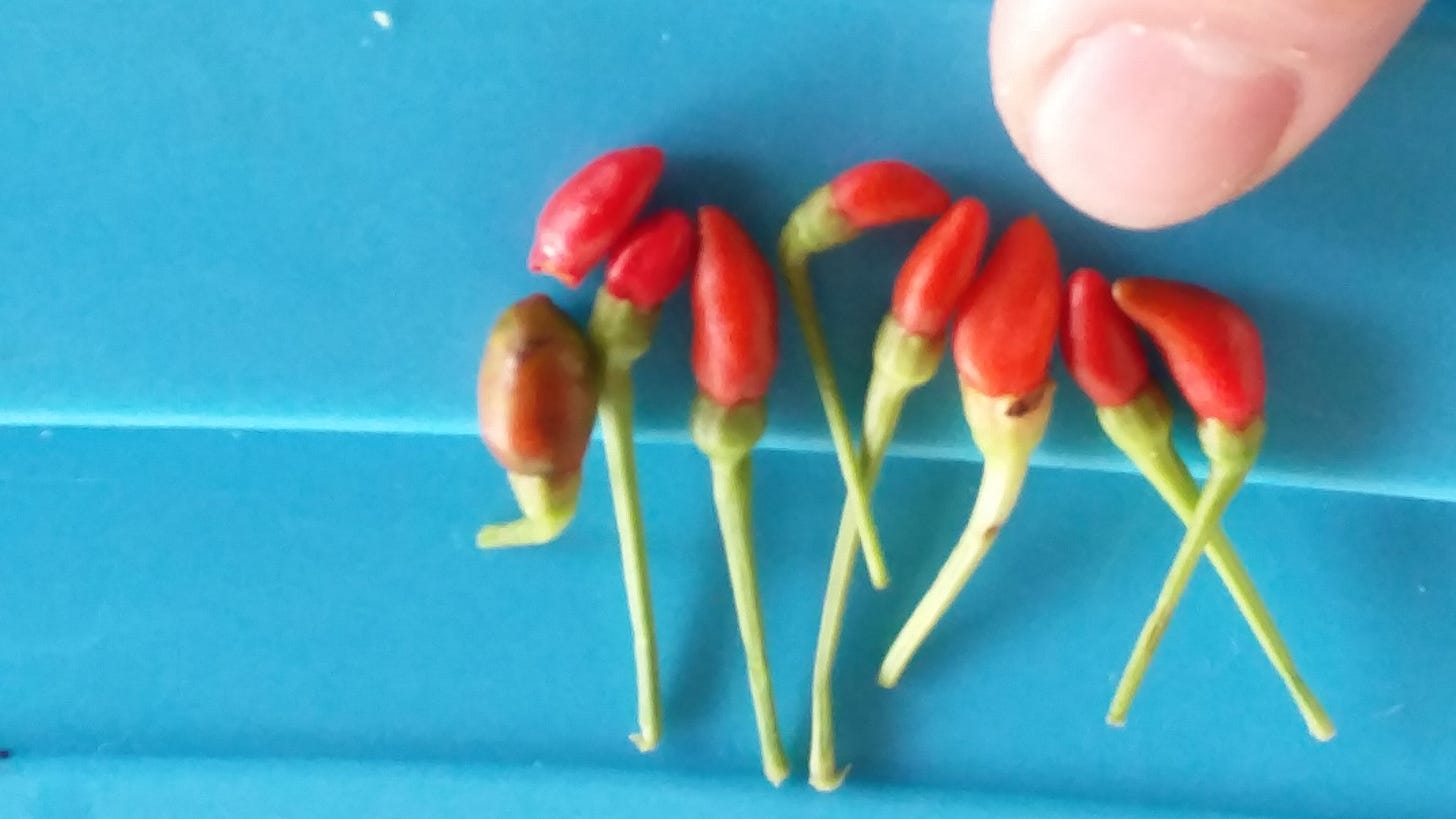
I'm curious what was the canape that made her have the impression it's spicy. :)
Bland?!? Oh hell naw!!! 😳 🤬